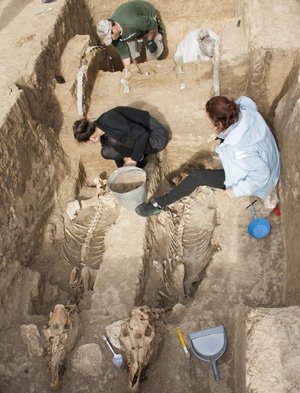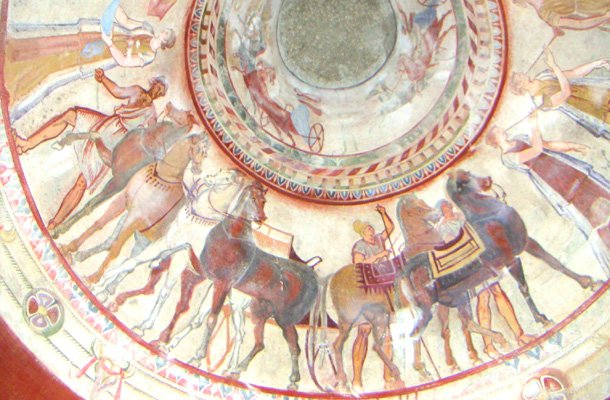
© Photo: BТА
A magnificent chariot with the remains of two horses was found near the village of Sveshtari /Northeast Bulgaria/ almost 2,300 years after its burial in the ground. The area is full of lots of Thracian mounds that have been surveyed for years. The archaeologists came upon another finding a few days ago and once again it exceeded their expectations.
Last autumn the expedition of Prof. Diana Gergova found in one of the mounds a treasury chest, containing gold bracelets, a diadem, rings, buttons and other objects with an overall weight of around 1.5 kg. Those supposedly belonged to King Kotela, who ruled the Thracian Getae tribe about 23 centuries ago. It became famous with its courage and magnificent culture. This year’s remains of the chariot have been dated to the end of the 4th – the beginning of the 3rd century BC. There are skeletons of two horses, harnessed in the chariot, as their heads have been laid on stone pillows, their front legs are bent under their bodies, while the rare ones are stretched, as if the animals are galloping to the world on the other side of life. However, the chariot itself astonished the archaeologists – it has only two and not four wheels that are pretty big with their diameter of 1.20 m. Besides that the construction is a lightweight one and very mobile. This appears to be the only one two-wheeled chariot from that period discovered, as only four-wheeled ones have been found so far. Another interesting thing is that an analogue of the chariot has been painted on the walls of the Kazanlak Thracian tomb. These vehicles were supposedly used not only in military competitions, but also for different religious rituals.

© Photo: Veneta Nikolova
“Are you aware that there were competitions too at the funerals of the Thracian rulers, as the chariot was sometimes a symbol of the moon and the coachman represented the middleman, who guided the soul of the dead man to the other world", Prof. Gergova explains. "So, for a first time we come upon a concrete illustration of how the ancient ones saw life and death.”
The Getae tribe believed in the astral immortality of the soul that left the body after the death, in order to interflow with the Universe. Our ancestors saw the relation with the stars as a sacred one. Supposedly this view was the basis of the unusual situation of the mounds at the plateau near Sveshtari. The scientists were surprised to find out that those cover the disposal of the Orion, Big Dog and Sagittarius constellations. The spots were probably used for cult ceremonies and funerals. “Those people were amazing philosophers, astronomers and mathematicians,” Prof. Gergova says with astonishment.
“The history and spirituality of the Getae tribe was related to the names of Pythagoras and Zalmoxis. Herodotus claimed that Zalmoxis, the semi-mythical tsar – god and priest of the tribe was a slave, a student, or even a predecessor of Pythagoras. So, this Greek point of view takes us back along the link of the ancient knowledge of our predecessors in the areas of mathematics, astronomy, philosophy etc.”
The mound with the chariot has been seriously attacked by treasure hunters, as traced by tractors and baggers. Besides that, the finding is in a good state. Prof. Gergova hopes to find the remains of the coachman and her hope is supported by the fact that the structures nearby remained untouched by the vandals. One way or another, the surprises are yet to come, the famous Bulgarian archaeologist is convinced. The plateau near Sveshtari is one of the most mystical places in this country and the mounds, many of those not researched yet, protect secrets that will be unveiled, sooner or later.
English version: Zhivko Stanchev
On the eve of St Athanasius' Day, one of the churches on the outskirts of Sofia is already preparing to welcome His Holiness the Metropolitan of Sofia and Bulgarian Patriarch Daniil , who this year will celebrate the Divine Liturgy in the church in the..
Atanasovden, also known as Midwinter in our folk calendar, is a holiday on which the Orthodox Church and our folklore pay tribute to St. Athanasius the Great – Archbishop of Alexandria and a fighter against Arianism (church heresy which rejects the..
The only chapel in the country to bear the names of Saints Anthony and Atha nasius is in Sandanski, and its consecration will be performed by His Eminence Metropolitan Seraphim of Nevrokop, reports Andon Kotev - one of the initiators of the idea to..
Every year on February 10, the feast of St. Haralambos , Bishop of Magnesia, is celebrated with special solemnity in a small Bulgarian town in the..

+359 2 9336 661
